The Ham Slicer Market is estimated to be valued at USD 632.5 million in 2025 and is projected to reach USD 1209.9 million by 2035, registering a compound annual growth rate (CAGR) of 6.7% over the forecast period.
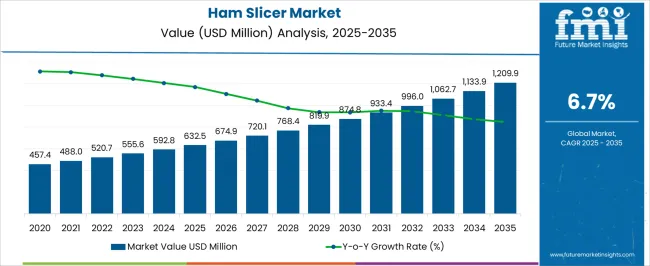
| Metric | Value |
|---|---|
| Ham Slicer Market Estimated Value in (2025 E) | USD 632.5 million |
| Ham Slicer Market Forecast Value in (2035 F) | USD 1209.9 million |
| Forecast CAGR (2025 to 2035) | 6.7% |
The Ham Slicer market is witnessing steady expansion, supported by the rising demand for precision slicing solutions across the foodservice and retail sectors. The current landscape is defined by increasing consumer expectations for uniform product quality, operational efficiency, and hygienic food preparation environments. This trend is being reinforced by technological upgrades in food processing equipment and stricter food safety regulations, as reported in industry trade publications and equipment manufacturer announcements.
Semi-automated and programmable slicers are gaining preference for their consistency, reduced labor dependency, and faster throughput. Growing urbanization and the proliferation of delis, supermarkets, and foodservice outlets are contributing to rising product adoption in both developed and emerging economies.
Equipment manufacturers are focusing on product innovation, durability, and ease of cleaning, aligning with operator needs in high-volume environments As observed in food equipment news articles and investor updates, the market outlook remains positive, with ongoing advancements in mechanical precision and increased automation expected to unlock further growth opportunities.
The market is segmented by Product Type and End User and region. By Product Type, the market is divided into Semi-automatic Ham Slicers and Automatic Ham Slicers. In terms of End User, the market is classified into Commercial and Household. Regionally, the market is classified into North America, Latin America, Western Europe, Eastern Europe, Balkan & Baltic Countries, Russia & Belarus, Central Asia, East Asia, South Asia & Pacific, and the Middle East & Africa.
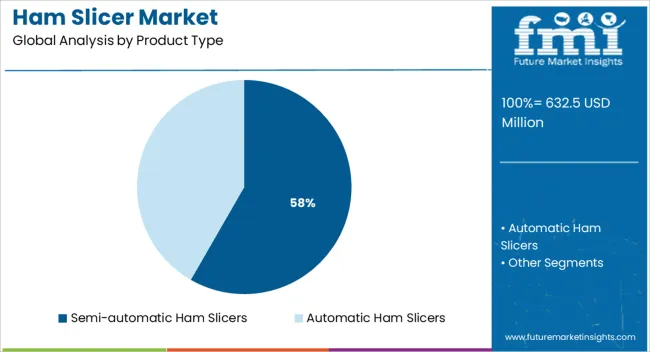
The semi-automatic ham slicers segment is expected to account for 58.3% of the Ham Slicer market revenue share in 2025, making it the dominant product type. This leadership is being driven by a balanced combination of manual control and mechanical efficiency, which meets the needs of both mid-scale foodservice operations and large-volume commercial kitchens.
Semi-automatic slicers are being widely adopted for their ease of use, reliable performance, and cost-efficiency, especially in settings where fully automatic systems may not be economically feasible. Equipment updates from manufacturers highlight the growing demand for machines that offer precision, safety features, and compact designs suitable for varied kitchen layouts.
The segment’s growth is further supported by the equipment’s adaptability across different meat textures and its lower maintenance requirements Increased awareness of hygiene standards and operator safety has also played a role in the continued preference for semi-automatic models, reinforcing their position as a versatile and practical choice for consistent slicing operations.
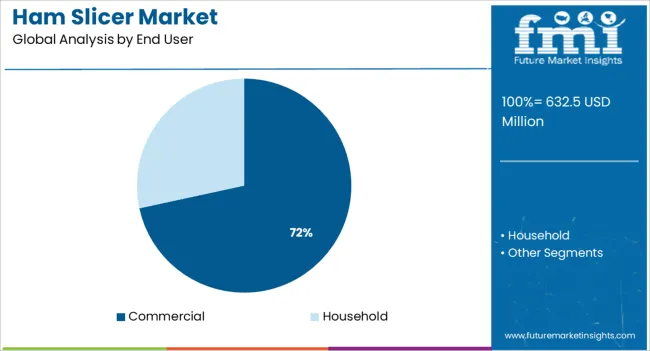
The commercial end user segment is projected to lead the Ham Slicer market with a 71.6% revenue share in 2025. This dominance is being shaped by the extensive use of ham slicers in supermarkets, delis, restaurants, and catering services, where efficiency, consistency, and hygiene are mission-critical. According to foodservice equipment updates and food retail industry news, commercial users prioritize slicers that offer high-volume throughput, ease of sanitation, and reliable safety mechanisms.
The segment’s growth is also supported by the continuous expansion of quick service restaurants and food retail chains, particularly in urban regions. Investments in back-of-house automation and the integration of semi-automatic machines into centralized kitchens are reinforcing adoption across commercial formats.
The focus on labor optimization, food waste reduction, and compliance with food safety regulations has further accelerated the demand for technologically advanced slicing equipment These dynamics are collectively ensuring the commercial segment’s continued leadership in the market.
As per FMI, the global ham slicer market is anticipated to expand at 6.7% CAGR between 2025 and 2035, in comparison to the 4.5% CAGR registered during the historical period from 2020 to 2025.
Rising consumption of meat products due to their high nutritional content and increasing adoption of advanced meat processing machines across households and commercial settings are the key factors driving the global ham slicer market.
Similarly, the growing focus of meat processing companies to improve overall productivity and reduce labor costs is expected to boost the demand for ham slicers during the next ten years.
Leading manufacturers of ham slicers are continuously focusing on introducing new products with additional features to increase their sales. This will further expand the ham slicer market size during the projected period.
With changing lifestyles, growing health awareness, and increasing disposable income, there has been a rapid surge in the consumption of meat products across the world. This in turn is generating huge demand for meat processing machinery like ham slicers and the trend is likely to continue during the forecast period
People are showing a keen inclination toward consuming protein-rich foods like steaks and meatballs. As a result, there has been a rapid rise in the production and consumption of meat products which will further escalate during the forthcoming years.
According to the Institute of Food Technologies (IFT), overall meat consumption across the world is expected to rise 1.4% per year through 2025. This increase in consumption of meat and meat-based products is expected to bolster the growth of the ham slicer market.
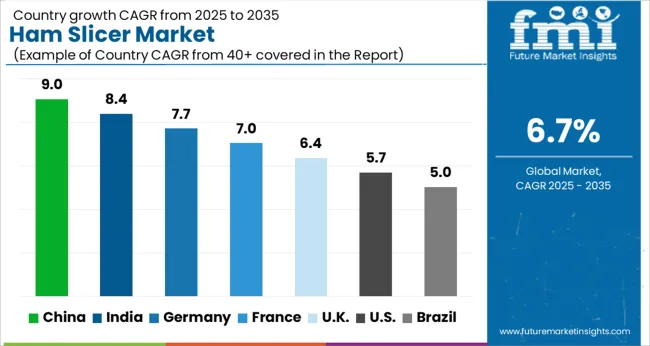
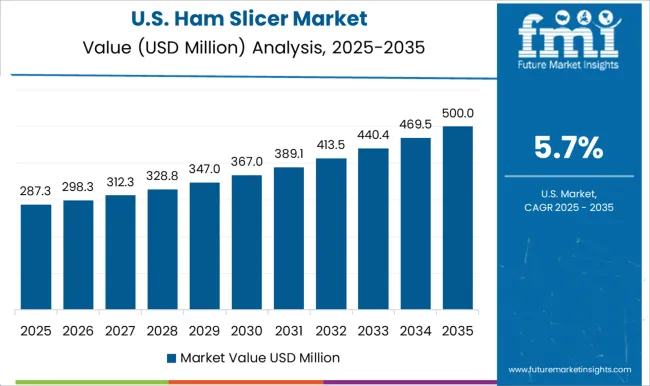
“Increasing Consumption of Meat and Pork Pushing Demand for Ham Slicers in the US”
As per FMI, the US ham slicer market size reached around USD 632.5 million in 2025 and it is poised to grow at a robust CAGR during the forecast period (2025 to 2035).
Rising consumption of meat products, especially beef and pork, rapid economic growth, and increasing adoption of advanced meat processing machinery across industrial and residential sectors are some of the key factors driving demand for ham slicers in the US market.
Similarly, the rapid boom of the pork industry across the US and the heavy presence of leading manufacturers are positively influencing ham slicer sales and the trend is likely to continue during the forecast period.
“Rapid Growth of Food Service Industry Boosting Market in the UK”
The UK ham slicer market is currently valued at USD 39.1 Million and it accounts for 22% of the Europe ham slicer market. Furthermore, demand for ham slicers in the UK is expected to rise at a healthy pace during the next ten years.
Growth in the UK ham slicer market is driven by rapid urbanization, changing lifestyles, increasing consumer spending, and the booming food service industry.
Similarly, the increasing adoption of ham slicers across households is another factor propelling sales in the UK market. Furthermore, advances in the commercial ham slicer sector, such as merging all process equipment into one to save human labor and increase sanitation standards, are projected to boost the market during the next ten years.
“Rise in Import of Meat Products Driving Ham Slicers Market Forward in China”
According to FMI, China's ham slicer machine market touched a valuation of USD 32.0 million in 2025 and it is poised to exhibit a strong growth rate during the next ten years. This can be attributed to the rapidly growing population with a wide range of socioeconomic and cultural characteristics, easy availability of meat processing equipment at lower costs, and growing meat consumption.
With changing lifestyles, there has been a sharp rise in the consumption of meat products like beef and pork across China. This in turn has increased the import of these products and the trend is likely to continue during the forecast period.
For instance, as per the US Department of Agriculture (USDA), pork imports in China will rise to 632.5 million MT in 2025 while beef imports will reach 3.3 million MT as consumer demand for pork and beef exceeds domestic production. Driven by this, demand for ham slicers is likely to grow at a robust pace during the projected period.
“Demand Likely to Remain High for Automatic Ham Slicers in 2025 & Beyond”
Based on product type, the global ham slicers market is segmented into semi-automatic ham slicers and automatic ham slicers. Among these, the automatic ham slicers segment is likely to witness the fastest growth during the forecast period.
This can be attributed to the rising adoption of automatic ham slicers across industrial and commercial sectors. Automatic ham slicers allow end users to significantly improve overall productivity while reducing labor costs. They are easy to use and slice meat into precise pieces.
“Commercial Segment to Generate Lucrative Opportunities for Ham Slicer Manufacturers”
Based on end users, the commercial segment is expected to grow at the fastest CAGR during the forecast period, owing to the rapid expansion of the HoReCa sector and the increasing usage of meat slicers across this industry.
As the demand for meat products continues to surge, end users like hotels and restaurants are increasingly adopting advanced machinery like meat slicers to meet this demand. This will generate lucrative growth opportunities for leading ham slicer manufacturers during the next ten years.
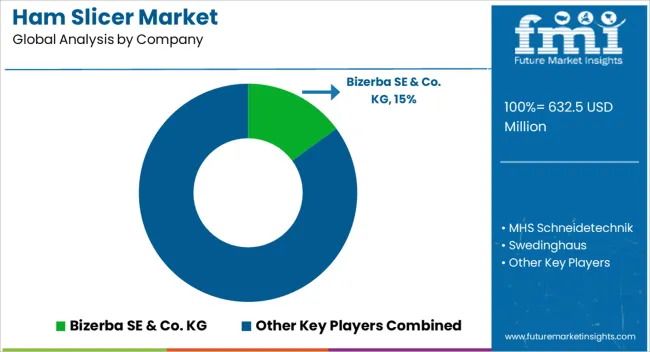
Leading manufacturers of ham slicers are continuously adopting strategies such as new product launches, partnerships, mergers, acquisitions, agreements, and collaborations to increase their sales and gain a competitive edge in the market. For instance,
Swedinghaus, Magurit Gefrierschneider GmbH, Foodmate, Bizerba SE & Co. KG, and Hallde are among the top players operating in this market space.
| Attribute | Details |
|---|---|
| Estimated Market Size (2025) | USD 632.5 million |
| Projected Market Size (2035) | USD 1209.9 million |
| Anticipated Growth Rate (2025 to 2035) | 6.7% CAGR |
| Forecast Period | 2025 to 2035 |
| Historical Data Available for | 2020 to 2025 |
| Market Analysis | USD Million for Value and Units for Volume |
| Key Regions Covered |
North America; Latin America; Europe; Asia Pacific; Oceania; Middle East & Africa (MEA) |
| Key Countries Covered | The US, Canada, Mexico, Germany, The UK, France, Italy, Spain, China, Japan, India, South Korea, Australia, Brazil, Argentina, South Africa, UAE |
| Key Segments Covered |
Product, Type, Application, Region |
| Key Companies Profiled |
MHS Schneidetechnik; Swedinghaus; Magurit Gefrierschneider GmbH; Foodmate; Bizerba SE & Co. KG; Hallde; Brunner GmbH; Bizerba SE & Co. KG; Devile Technologies; Wente-Thiedig GmbH; Sirman; Dadaux; Moffat; NOAW; Birko; Fushilong |
| Report Coverage | Market Forecast, Company Share Analysis, Competitive Landscape, DROT Analysis, Market Dynamics and Challenges, and Strategic Growth Initiatives |
The global ham slicer market is estimated to be valued at USD 632.5 million in 2025.
The market size for the ham slicer market is projected to reach USD 1,209.9 million by 2035.
The ham slicer market is expected to grow at a 6.7% CAGR between 2025 and 2035.
The key product types in ham slicer market are semi-automatic ham slicers and automatic ham slicers.
In terms of end user, commercial segment to command 71.6% share in the ham slicer market in 2025.






Full Research Suite comprises of:
Market outlook & trends analysis
Interviews & case studies
Strategic recommendations
Vendor profiles & capabilities analysis
5-year forecasts
8 regions and 60+ country-level data splits
Market segment data splits
12 months of continuous data updates
DELIVERED AS:
PDF EXCEL ONLINE
Hammer Mill Market Size and Share Forecast Outlook 2025 to 2035
Hammocks Market Size and Share Forecast Outlook 2025 to 2035
Competitive Landscape of Hammer Mill Market Share
Chamomile Extracts for Soothing Market Analysis - Size, Share, and Forecast Outlook 2025 to 2035
Chamber Belt Vacuum Machine Market Analysis Size and Share Forecast Outlook 2025 to 2035
Chamomile Oil Market Size, Growth, and Forecast for 2025 to 2035
Chamomile Seeds Market – Growth & Demand 2025 to 2035
Champagne Market Analysis by Price Range, Sales Channel, and Region Through 2035
Carthamus Yellow Market
Pet Shampoo Market Size and Share Forecast Outlook 2025 to 2035
Hot Chamber Die Casting Machine Market Growth - Trends & Forecast 2025 to 2035
Market Share Breakdown of Pet Shampoo Manufacturers
Rice Shampoo Bar Market Size and Share Forecast Outlook 2025 to 2035
Kids Shampoo Market Size and Share Forecast Outlook 2025 to 2035
Dual Chamber Dispensing Bottles Market Size and Share Forecast Outlook 2025 to 2035
Dual-Chamber Pumps Market Analysis - Size, Share, and Forecast Outlook (2025 to 2035)
Market Share Breakdown of Rice Shampoo Bar Manufacturers
Dual Chamber Bottle Market Insights – Size, Trends & Forecast 2024-2034
Vacuum Chamber Pouches Market Size and Share Forecast Outlook 2025 to 2035
Sorting Hampers Market Size and Share Forecast Outlook 2025 to 2035

Thank you!
You will receive an email from our Business Development Manager. Please be sure to check your SPAM/JUNK folder too.
Chat With
MaRIA